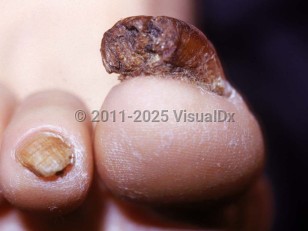Onychogryphosis - Nail and Distal Digit
Alerts and Notices
Important News & Links
Synopsis

Onychogryphosis (sometimes called "claw nail") is a disorder of the nail that is usually acquired but may be inherited. It most commonly affects the toenails, particularly the hallux. The nail plate presents as unevenly thickened, opaque, elongated, increased in curvature, often yellow-brown in color, and can show superficial transverse striations. The thickened nail can also be severely distorted and laterally displaced, giving it a shape like a ram's horn, causing pain and interfering with footwear and ambulation.
In the elderly population, the nail dystrophy is usually caused by microtrauma from poor-fitting footwear but is also seen with impairment of the peripheral vascularization, stasis dermatitis, onychomycosis, self-neglect, and orthopedic deformities such as hallux valgus and erectus.
Onychogryphosis may also be associated with injury to the matrix in patients with psoriasis or ichthyosis, diseases of the central nervous system, hyperuricemia, and impairment of the peripheral circulation.
Hereditary onychogryphosis has been rarely described. All the nails of both hands and feet may be involved. It is inherited as an autosomal dominant trait. Onychogryphosis has also been described as a feature of Haim-Munk syndrome, tuberous sclerosis, Papillon-Lefèvre syndrome, ichthyosis hystrix, and ectodermal dysplasia-syndactyly syndrome type 1.
In the elderly population, the nail dystrophy is usually caused by microtrauma from poor-fitting footwear but is also seen with impairment of the peripheral vascularization, stasis dermatitis, onychomycosis, self-neglect, and orthopedic deformities such as hallux valgus and erectus.
Onychogryphosis may also be associated with injury to the matrix in patients with psoriasis or ichthyosis, diseases of the central nervous system, hyperuricemia, and impairment of the peripheral circulation.
Hereditary onychogryphosis has been rarely described. All the nails of both hands and feet may be involved. It is inherited as an autosomal dominant trait. Onychogryphosis has also been described as a feature of Haim-Munk syndrome, tuberous sclerosis, Papillon-Lefèvre syndrome, ichthyosis hystrix, and ectodermal dysplasia-syndactyly syndrome type 1.
Codes
ICD10CM:
L60.2 – Onychogryphosis
SNOMEDCT:
52897009 – Onychogryposis
L60.2 – Onychogryphosis
SNOMEDCT:
52897009 – Onychogryposis
Look For
Subscription Required
Diagnostic Pearls
Subscription Required
Differential Diagnosis & Pitfalls

To perform a comparison, select diagnoses from the classic differential
Subscription Required
Best Tests
Subscription Required
Management Pearls
Subscription Required
Therapy
Subscription Required
References
Subscription Required
Last Reviewed:07/02/2018
Last Updated:05/19/2024
Last Updated:05/19/2024
 Patient Information for Onychogryphosis - Nail and Distal Digit
Patient Information for Onychogryphosis - Nail and Distal Digit
Premium Feature
VisualDx Patient Handouts
Available in the Elite package
- Improve treatment compliance
- Reduce after-hours questions
- Increase patient engagement and satisfaction
- Written in clear, easy-to-understand language. No confusing jargon.
- Available in English and Spanish
- Print out or email directly to your patient
Upgrade Today

Onychogryphosis - Nail and Distal Digit

